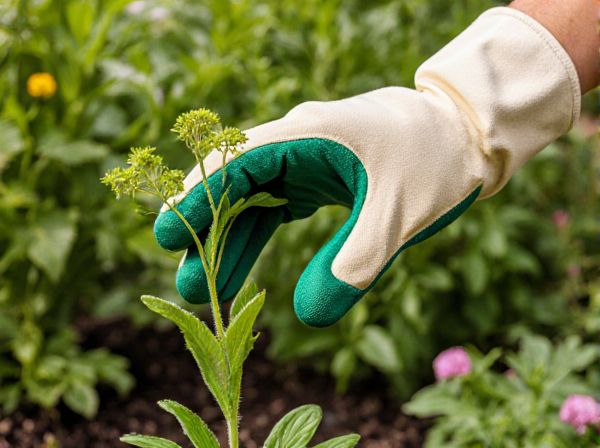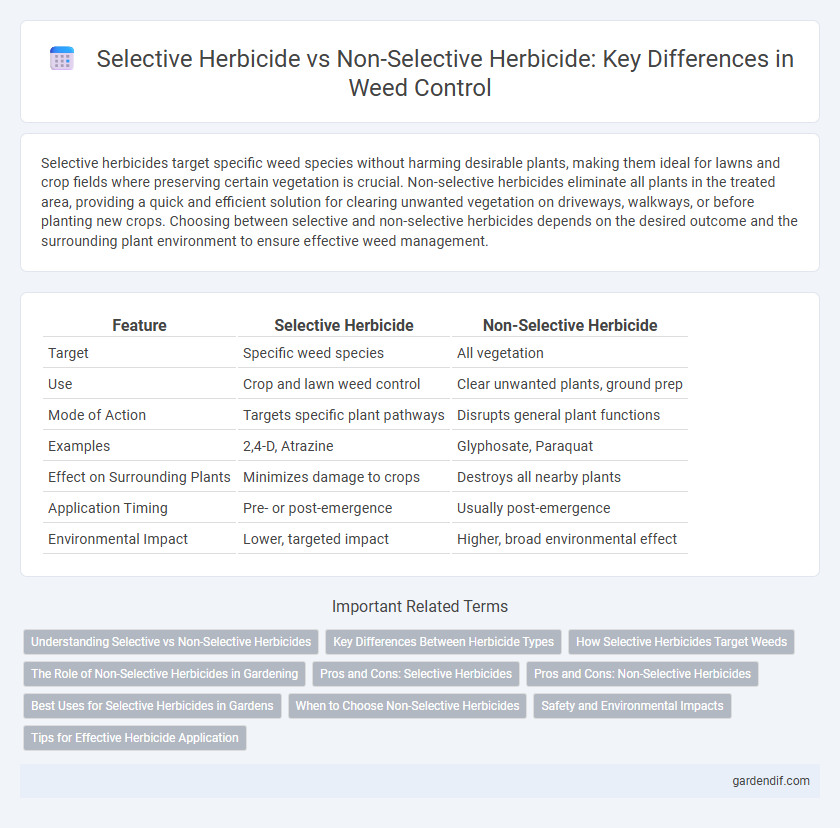
Selective herbicide vs Non-selective herbicide Illustration
Selective herbicides target specific weed species without harming desirable plants, making them ideal for lawns and crop fields where preserving certain vegetation is crucial. Non-selective herbicides eliminate all plants in the treated area, providing a quick and efficient solution for clearing unwanted vegetation on driveways, walkways, or before planting new crops. Choosing between selective and non-selective herbicides depends on the desired outcome and the surrounding plant environment to ensure effective weed management.
Table of Comparison
| Feature | Selective Herbicide | Non-Selective Herbicide |
|---|---|---|
| Target | Specific weed species | All vegetation |
| Use | Crop and lawn weed control | Clear unwanted plants, ground prep |
| Mode of Action | Targets specific plant pathways | Disrupts general plant functions |
| Examples | 2,4-D, Atrazine | Glyphosate, Paraquat |
| Effect on Surrounding Plants | Minimizes damage to crops | Destroys all nearby plants |
| Application Timing | Pre- or post-emergence | Usually post-emergence |
| Environmental Impact | Lower, targeted impact | Higher, broad environmental effect |
Understanding Selective vs Non-Selective Herbicides
Selective herbicides target specific weed species without harming desired plants, making them ideal for use in lawns, gardens, and crop fields where preserving certain vegetation is crucial. Non-selective herbicides eliminate all vegetation they contact, providing a quick and effective solution for total weed control in industrial sites, driveways, or before planting new crops. Understanding the differences between these herbicide types helps optimize weed management strategies by balancing effective control with the protection of valuable plants.
Key Differences Between Herbicide Types
Selective herbicides target specific weed species while leaving desirable plants unharmed, making them ideal for use in lawns and crop fields to control particular weeds. Non-selective herbicides kill or damage all plants they come into contact with, providing effective weed clearance in areas like driveways, industrial sites, or before planting new crops. Key differences include their spectrum of action, application timing, and safety to non-target vegetation.
How Selective Herbicides Target Weeds
Selective herbicides target weeds by exploiting specific physiological or biochemical differences between weed species and desired crops, such as variations in enzyme systems or metabolic pathways. These herbicides interfere with growth processes unique to broadleaf or grassy weeds without damaging the crop, allowing for precise weed control in agricultural or lawn settings. The mode of action often involves inhibiting photosynthesis, amino acid synthesis, or cell division in target weeds while leaving resistant plants unaffected.
The Role of Non-Selective Herbicides in Gardening
Non-selective herbicides play a crucial role in gardening by effectively eliminating all types of vegetation, making them ideal for clearing unwanted weeds from driveways, pathways, and garden beds before planting. Unlike selective herbicides, which target specific weed species without harming desirable plants, non-selective herbicides provide a fast and thorough weed control solution, reducing labor and maintenance efforts. Using non-selective herbicides with care can prepare soil beds for new plantings and prevent weed resurgence, ensuring healthier garden growth.
Pros and Cons: Selective Herbicides
Selective herbicides target specific weed species while sparing desirable plants, making them ideal for maintaining crop health and biodiversity. Their precision reduces the risk of damaging valuable crops, but they may require accurate identification of weed species and are often more expensive than non-selective alternatives. Limitations include potential resistance development and reduced effectiveness against mixed or unknown weed populations.
Pros and Cons: Non-Selective Herbicides
Non-selective herbicides, such as glyphosate and glufosinate, effectively eliminate a wide range of unwanted vegetation, making them ideal for clearing large areas quickly. They can damage or kill desirable plants, requiring careful application to avoid crop loss and environmental harm. Their broad-spectrum nature reduces the need for multiple products but increases the risk of soil and water contamination if used improperly.
Best Uses for Selective Herbicides in Gardens
Selective herbicides are ideal for garden use since they target specific weed species without harming desirable plants, preserving the aesthetic and health of flower beds and vegetable patches. These herbicides are best utilized when managing broadleaf weeds among grasses or controlling invasive plants around ornamentals, ensuring a balanced ecosystem. Using selective herbicides reduces the need for manual weeding and supports sustainable garden maintenance by protecting beneficial flora.
When to Choose Non-Selective Herbicides
Non-selective herbicides are ideal for eliminating all vegetation in areas like driveways, sidewalks, or land clearing before planting. They are typically chosen when total weed control is necessary and selective herbicides would not be effective due to mixed or dense weed populations. Products containing glyphosate or glufosinate provide broad-spectrum control, ensuring rapid and comprehensive weed elimination.
Safety and Environmental Impacts
Selective herbicides target specific weed species while minimizing harm to desirable plants, reducing the risk of crop damage and promoting safer agricultural practices. Non-selective herbicides eliminate all vegetation they contact, increasing the potential for environmental contamination and requiring careful application to avoid unintended ecosystem disruption. The use of selective herbicides generally results in lower environmental toxicity and improved safety for surrounding flora and fauna compared to non-selective herbicides.
Tips for Effective Herbicide Application
Selective herbicides target specific weed species while sparing desired plants, requiring precise identification and timing for optimal results. Non-selective herbicides eliminate most vegetation, demanding careful application to prevent damage to surrounding crops or landscape features. Calibrating sprayers correctly and applying herbicides under ideal weather conditions, such as low wind and moderate temperature, enhances efficacy and minimizes environmental impact.
Selective herbicide vs Non-selective herbicide Infographic

 gardendif.com
gardendif.com